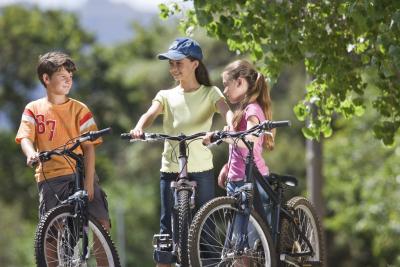Exercise is not only healthy for adults, it’s just as essential for kids, too. Regular exercise also helps children to feel good about themselves and increases their self-esteem. Although a lot of kids get their exercise by playing team sports, if your child doesn’t play sports, she can get exercise on her own in several enjoyable ways.
Cardiovascular Exercises
The American Heart Association recommends that children ages two and older get at least 30 minutes of moderate intensity physical activity every day. Activities should be fun, varied and developmentally age appropriate. All children and adolescents need to be physically active for better health. If your child spends too much time watching television, playing video games or sitting at the computer, encourage him to be more active in general. Playing outside, running, riding a bicycle, jumping rope, walking and swimming are just some of the ideas for activities that provide healthy cardio exercise by getting your child to move around.
Stretching Exercises
The findings of a study published in a 2005 issue of the “School Psychology Review” suggest that yoga or a regular program of stretching exercises may help students concentrate on classroom tasks for longer periods of time. Yoga in particular can benefit children by teaching them how to relax and focus. Other stretching exercises like the back twist can help relax muscles that tense from carrying books in backpacks and sitting at a desk or computer. The gentle side-to-side twisting motion loosens tight muscles in the neck, upper and lower back, hips and waist. Do the stretching exercise with your child. Stand with your back straight, feet shoulder width apart and arms hanging loosely at your sides. Moving only your upper body and arms, gently twist your upper body and head to the right until you are looking behind you. Your legs and feet should still be pointing forward. Slowly turn back toward the front and then repeat the exercise on the left side. Continue to alternate sides, doing the exercise for a few minutes at a time.
Body-Weight Exercises
Body-weight exercises can help develop a child’s balance. Push-ups, pull-ups, squats, lunges and crunches are simple body-weight exercises that most kids can do. Hanging on a chin-up bar or climbing a rope can also improve a child’s grip strength. Make sure your child has the strength and motor skills to perform these basic exercises. Teach your child to stretch and warm up first. Kids often enjoy jumping rope or doing jumping jacks. Both of these activities provide a way for a child to warm up before moving on to resistance and strength training exercise.
Strength Training
MayoClinic.com points out that strength training offers many benefits to children as long as the focus is on safety and the use of proper technique. Some of the benefits of strength training include increasing a child’s muscle strength and endurance, improving motor skills, increasing bone density and reducing the risk of injury. Most children can begin including strength training in a fitness program by age 8 as long as a child’s pediatrician approves. Both the American Academy of Pediatrics and American College of Sports Medicine recommend performing strength training exercises that target all major muscle groups. A child should do one to three sets of each exercise, including six to 15 repetitions in each set. Allow your child to master the movements first without the use of weights. Running, biking and skating are other options for working the leg muscles. Activities like wrestling and climbing the monkey bars at the playground can help build muscle strength in the arms.
Flexibility Training
Keeping the muscles and joints flexible decreases the risk of muscle strains and sprains. Flexibility exercises help the muscles and joints stretch and bend easily. Children often enjoy participating in activities like karate, gymnastics, Pilates or ballet. Any of these activities helps to increase a child’s flexibility.





